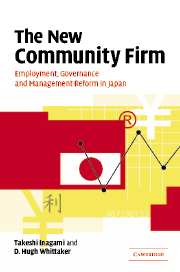Book contents
- Frontmatter
- Contents
- List of figures
- List of tables
- Preface
- Acknowledgements
- Part 1 The End of the Community Firm?
- 1 Company as Community
- 2 The Classic Model: Benchmark for Change
- 3 Change and Continuity
- 4 Company Professionals and Creative Work
- 5 Corporate Governance and Managers' Ideologies
- 6 Consolidated Management and Quasi Internal Labour Markets
- 7 Summing Up
- Part 2 Hitachi: ‘Here, the Future’
- Part 3 The Reformed Model
- Appendix: Changes in Job Tenure
- References
- Index
4 - Company Professionals and Creative Work
Published online by Cambridge University Press: 22 September 2009
- Frontmatter
- Contents
- List of figures
- List of tables
- Preface
- Acknowledgements
- Part 1 The End of the Community Firm?
- 1 Company as Community
- 2 The Classic Model: Benchmark for Change
- 3 Change and Continuity
- 4 Company Professionals and Creative Work
- 5 Corporate Governance and Managers' Ideologies
- 6 Consolidated Management and Quasi Internal Labour Markets
- 7 Summing Up
- Part 2 Hitachi: ‘Here, the Future’
- Part 3 The Reformed Model
- Appendix: Changes in Job Tenure
- References
- Index
Summary
For the classic model to survive, skill development which increases corporate value cannot fall below the age–wage curve in the long term. As we saw in chapter 3, there are problems in this regard, but to date none of them appears fatal. However, we need to look more closely at this proposition in the light of the changing nature of competition facing Japanese companies. Japanese companies are being pushed relentlessly in the direction of higher value added, knowledge-based, aesthetically creative (‘smart’) products and services, and need an employment system which can deliver these. Can the classic model methods of long-term skill development also nurture creative work? Is high value added, white-collar creative work compatible with classic model employment practices?
Chapter 4 examines these questions, looking first at the changing nature of value creation, and the rise of ‘company (or organization) professionals’. Managers in many countries have struggled to devise personnel systems capable of motivating and rewarding such employees, and Japan is no exception. In the 1990s leading companies refined their human resource management (HRM) systems for this purpose. We will examine Hitachi's response in Part 2; here we will focus on creative work itself, and those who do it. For this we will look at evidence from a questionnaire about creative work carried out in the mid-1990s.
Company professionals
Until the mid-1980s in the manufacturing sector, the focus of Japanese managers' concern was in their factories, especially their production departments. This was where competitiveness was seen to lie.
- Type
- Chapter
- Information
- The New Community FirmEmployment, Governance and Management Reform in Japan, pp. 51 - 68Publisher: Cambridge University PressPrint publication year: 2005



